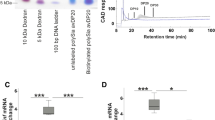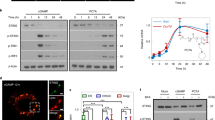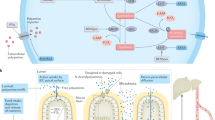Abstract
MANY tumour growth inhibiting substances have been studied in various tumour systems: aliphatic diamines, hydroxy-amines, aromatic bases with two terminal groups1, the synthetic polypeptides of lysine such as positively charged poly-DL-lysine2, polyornithine3, histones4, lysine-rich histone fractions5, DEAE-dextran6,7, polyethylenimine8,9, polyvinylamine bisulphate and polypropylenimine9. The synthetic double-stranded ribonucleic acid—a complex of polyinosinic acid and polycytidylic acid—(poly I.poly C), which is highly negatively charged, has also been demonstrated to inhibit the growth of several transplantable malignant murine tumours of known or unknown viral aetiology10–17. Some reports describe the protective action of poly I.poly C on non-viral diseases as well10,18. Certain polysaccharides isolated from lichens significantly inhibited the growth of implanted sarcoma-180 in mice and caused complete tumour regression in many cases19, whereas acid mucopolysaccharides promoted tumour growth20–29.
This is a preview of subscription content, access via your institution
Access options
Subscribe to this journal
Receive 51 print issues and online access
$199.00 per year
only $3.90 per issue
Buy this article
- Purchase on Springer Link
- Instant access to full article PDF
Prices may be subject to local taxes which are calculated during checkout
Similar content being viewed by others
References
Boyland, E., Biochem. J., 35, 1283 (1941).
Richardson, T., Hodgett, J., Linner, A., and Stahmann, M. A., Proc. Soc. Exp. Biol. Med., 101, 382 (1959).
Larsen, B., and Olsen, K., Europ. J. Cancer, 4, 157 (1968).
Vorobyer, V. I., and Bresler, V. M., Nature, 198, 545 (1963).
Shah, V. C., and Reilly, P., Nature, 213, 403 (1967).
Larsen, B., and Thorling, E. B., Acta Path. Microbiol. Scand., 75, 229 (1969).
Thorling, E. B., and Larsen, B., Acta Path. Microbiol. Scand., 75, 237 (1969).
Ambrose, E. J., Easty, D. M., and Jones, P. C. T., Brit. J. Cancer, 12, 439 (1958).
Furlan, M., and Moroson, H., in Radiation Protection and Sensitization (edit by Moroson, H. L., and Quintiliani, M.), p. 233 (Taylor and Francis, London, 1970).
Levy, H. B., Law, L. W., and Rabson, A. S., Proc. US Nat. Acad. Sci, 62, 357 (1969).
Zeleznick, L. D., and Bhuyan, B. K., Proc. Soc. Exp. Biol. Med., 130, 126 (1969).
Rhim, J. S., Greenawalt, C., and Huebner, R. J., Nature, 222, 1166 (1969).
Sarma, P. S., Shiu, G., Baron, S., and Huebner, R. J., Fed. Proc., 28, 297 (1969).
Author information
Authors and Affiliations
Rights and permissions
About this article
Cite this article
MEHRISHI, J. Cell Surface Charge Increase by both Tumour Inhibitory and Tumour Growth Promoting Polyanions. Nature 228, 364–365 (1970). https://doi.org/10.1038/228364a0
Received:
Revised:
Issue Date:
DOI: https://doi.org/10.1038/228364a0
This article is cited by
-
Non-viral cancer gene therapy: Beyond delivery
Gene Therapy (2006)
-
Histochemical effects of the proteolytic enzyme brinase on ascites tumour cells
Irish Journal of Medical Science (1975)
-
Surface molecular components of Ehrlich ascites tumour cells
Blut Zeitschrift für die Gesamte Blutforschung (1972)
Comments
By submitting a comment you agree to abide by our Terms and Community Guidelines. If you find something abusive or that does not comply with our terms or guidelines please flag it as inappropriate.



